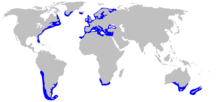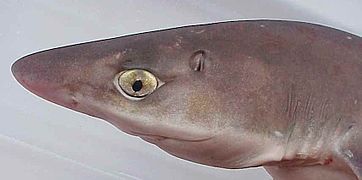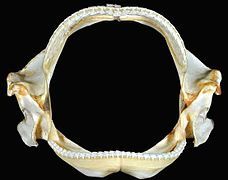Spiny dogfish
| Spiny dogfish Temporal range:
| |
|---|---|

| |
| Scientific classification | |
| Domain: | Eukaryota |
| Kingdom: | Animalia |
| Phylum: | Chordata |
| Class: | Chondrichthyes |
| Subclass: | Elasmobranchii |
| Order: | Squaliformes |
| Family: | Squalidae |
| Genus: | Squalus |
| Species: | S. acanthias
|
| Binomial name | |
| Squalus acanthias | |

| |
| Range of the spiny dogfish (in blue) | |
The spiny dogfish (Squalus acanthias), spurdog, mud shark, or piked dogfish[4] is one of the best known species of the Squalidae (dogfish) family of sharks, which is part of the Squaliformes order.[5]
While these common names may apply to several species, Squalus acanthias is distinguished by two spines (one anterior to each dorsal fin) and no anal fin. It lives in shallow waters and further offshore in most parts of the world, especially in temperate waters. Those in the northern Pacific Ocean were reevaluated in 2010 and found to constitute a separate species, now called the Pacific spiny dogfish (Squalus suckleyi).[6]
Description and behaviour
[edit]
The spiny dogfish has dorsal fins, no anal fin, and white spot along its back. The caudal fin has asymmetrical lobes, forming a heterocercal tail. The species name acanthias refers to the shark's two spines. These are used defensively. If captured, the shark can arch its back to pierce its captor with spines near the dorsal fins that secrete a mild venom into its predator.[7]
This shark is known to hunt in packs that can range up into the thousands. They are aggressive hunters and have a sizable diet that can range from squid, fish, crab, jellyfish, sea cucumber, shrimp and other invertebrates.[8]
Dogfish sharks experience one of the longest gestation periods of any organism, which can last from around 18 to 24 months. During spawning season, which occurs during the colder months of winter, females can lay anywhere from 2 to 12 eggs, which develop ovoviviparously and the pups are birthed as live young, with about 5 to 6 in each litter of pups, mainly depending on the size of the female. Reproduction occurs in the winter in offshore waters, while pups are normally born in the warmer and deeper offshore waters where it is harder for humans and predators to reach them. The reproductive cycle begins when females produce several large eggs of yellow coloring, which become fertilized once they pass through the shell gland and are wrapped in what is called a "candle", or a kind of reproductive capsule. One can determine if an egg is fertilized when the blastoderm is visible. The candle passes through the rest of the reproductive tract until it reaches the uterus. Attached to the gill region of the pup is a yolk sac which provides nutrients for them as they develop, which they absorb as they grow. Even after fully absorbing the yolk sac, the pups may live in the uterus for a period of time afterwards during the gestation period.[9][10] Both sexes are greyish brown in color and are countershaded. Males are identified by a pair of pelvic fins modified as sperm-transfer organs, or "claspers". The male inserts one clasper into the female cloaca during copulation.
In females the size of ova and the state of uteri determines whether sexual maturity has been reached, while in males, clasper length and calcification is the determination factor. Many of the growth patterns show an isometric growth pattern, as the pups have very similar features to the adults. Sexual maturity does not match body size development, they mature quite earlier than one would expect. Most males reach sexual maturity at an earlier ages of around 10 years, growing to be about 60–65 cm in length. Females take a longer period of time, around 16 years, to reach sexual maturity, and can grow to about 80–84 cm (30–30 in) at that time. Some dogfish have been seen to live nearly 70 years, but the average lifespan is around 30–40 years.[11][12] Male Spiny dogfish use their claspers to impregnate females, which take time to develop properly, and before reaching sexual maturity, tend to be longer than their pelvic fins. During this time, the testes develop, but no sperm will exist inside until later stages are reached, and genital ducts are deformed compared to adult ducts. Once the adult stage is reached, claspers have elongated, and are now hardened with calcium and are still slightly longer than their pelvic fin. At this point testes are fully developed, and sperm exist within the seminal vesicles, and genital ducts conform to a twisted shape we commonly see in adults.[13]
Spiny dogfish are bottom-dwellers. They are commonly found at depths of around 50–149 m (160–490 ft), but have been found deeper than 700 m (2,300 ft).[14]
Life span estimates based on analysis of vertebral centra and annuli in the dorsal spines range from 35 to 54 years.[15]
-
Head
-
Jaws
-
Upper teeth
-
Lower teeth
Commercial use
[edit]
Spiny dogfish are sold as food in Europe, the United States, Canada, New Zealand,[16] Venezuela and Chile. The meat is primarily eaten in England, France, Italy, the Benelux countries, Germany, and as an unwitting houndshark in Greece. The fins and tails are processed into fin needles for cheaper versions of shark fin soup in Chinese cuisine.[citation needed] In England, dogfish are bought in fish and chip shops as "huss", and previously as "rock salmon" until the term was outlawed. Commercial harvests were banned in the UK from 2010 until 2023.[17] In France, they are sold as "small salmon" (saumonette) and in Belgium and Germany as "sea eel" (zeepaling and Seeaal, respectively). In Greece, all small dogfish are commercially called galéos, after the critically endangered Galeorhinus galeus that produces a seasonal dish; other small sharks such as the spiny dogfish substitute it.
Spiny dogfish bodies are ground into fertilizer, liver oil and pet food. Because of their availability, cartilaginous skulls and small sizes, they are popular vertebrate dissection specimens in high schools and universities.
Reported catches varied between 31,700 tonnes in 2000 and 13,800 tonnes in 2008.[18] Bottom trawlers and sink gillnets are the primary tools. In Mid-Atlantic and Southern New England fisheries, they are often caught with larger groundfish, classified as bycatch, and discarded. Recreational fishing accounts for an insignificant portion of the spiny dogfish catch.[19]
The Cape Cod Commercial Fishermen's Alliance promotes sustainable use of the dogfish in restaurants and fish markets in the Cape Cod area of Massachusetts, as of 2017, paid for by the National Oceanographic and Atmospheric Administration. It aims to persuade diners to buy less-popular fish.[20]
Conservation status and management
[edit]Once the most abundant shark species in the world, populations of Squalus acanthias have declined significantly. They are classified in the IUCN Red List of threatened species as Vulnerable globally and Critically endangered in the Northeast Atlantic, meaning stocks around Europe have decreased by at least 95%. This is a direct result of overfishing to supply northern Europe's taste for rock salmon, saumonette, and zeepaling. Despite these alarming figures, very few management or conservation measures are in place for Squalus acanthias.[2] In EU waters, a Total Allowable Catch (TAC) has been in place since 1999, but until 2007 it only applied to ICES Areas IIa and IV. It was also set well above the actual weight of fish being caught until 2005, rendering it meaningless. Since 2009 a maximum landing size of one metre (3 ft 3 in) has been imposed in order to protect the most valuable mature females. The TAC for 2011 was set at 0 tons, ending targeted fishing for the species in EU waters. It remains to be seen if populations will be able to recover.[21]
In the recent past[when?] the European market for spiny dogfish has increased dramatically, which led to the overfishing and decline of the species. This drastic increase led to the creation and implementation of many fishery management policies placing restrictions on the fishing of spiny dogfish. However, since the species is a late-maturing fish, it takes a while[quantify] to rebuild the population.
In 2010, Greenpeace International added the spiny dogfish to its seafood red list. "The Greenpeace International seafood red list is a list of fish that are commonly sold in supermarkets around the world, and which have a very high risk of being sourced from unsustainable fisheries."[22] In the same year, the Convention on Migratory Species (CMS; also known as the Bonn Convention) listed the species (Northern Hemisphere populations) under Annex I of its Migratory Shark Memorandum of Understanding.[23]
In recent years, however, the US has implemented fishing controls and opened up the fishery.[clarification needed] The proposed quota for 2011 was 16.1 million kilograms (35.5 million lb) with a trip limit of 1,800 kg (4,000 lb), an increase over past years in which the quota has ranged from 2 to 9 million kilograms (5 to 20 million lb), with trip limits from 900 to 1,400 kg (2,000 to 3,000 lb).[24] In 2010, NOAA announced the Eastern US Atlantic spiny dogfish stocks to be rebuilt,[25] and in 2011, concerns about dogfish posing a serious predatory threat to other stocks resulted in an emergency amendment of the quota with nearly 6.8 million kilograms (15 million lb) being added.[26]
In June 2018, the New Zealand Department of Conservation classified Squalus acanthias Linnaeus as "Not Threatened" with the qualifier "Secure Overseas" under the New Zealand Threat Classification System.[27]
In 2023, populations in EU and UK waters were determined to have recovered enough that they could be commercially fished.[28]
Fossil range
[edit]This section needs expansion. You can help by adding to it. (June 2019) |
Squalus acanthias fossils are known from the Miocene of Denmark and the Netherlands, dating from approximately 11 million years ago.[1] As with other cartilaginous fish, the fossil record of Squalus acanthias consists predominantly of dental material, as cartilage does not fossilize well. The teeth of S. acanthias can be hard to differentiate from those of other squaliforme sharks,[29] making identification difficult.
References
[edit]- ^ a b "Squalus acanthias Linnaeus 1758 (spiny dogfish)". 2021. Retrieved 17 December 2021.
- ^ a b Finucci, B.; Cheok, J.; Chiaramonte, G.E.; Cotton, C.F.; Dulvy, N.K.; Kulka, D.W.; Neat, F.C.; Pacoureau, N.; Rigby, C.L.; Tanaka, S.; Walker, T.I. (2020). "Squalus acanthias". IUCN Red List of Threatened Species. 2020: e.T91209505A124551959. doi:10.2305/IUCN.UK.2020-3.RLTS.T91209505A124551959.en. Retrieved 12 November 2021.
- ^ "Squalus acanthias". NatureServe Explorer. Retrieved 17 April 2024.
- ^ "Squalus acanthias". Florida Museum. 2017-05-12. Retrieved 2018-12-03.
- ^ "Species Squalus acanthias Linnaeus". FishWisePro. 1758. Retrieved 18 April 2020.
- ^ Ebert, D. A.; White, W.T.; Goldman, K. J.; Compagno, L. J.; Daly-Engel, T. S. & Ward, R. D. (2010). "Resurrection and redescription of Squalus suckleyi (Girard, 1854) from the North Pacific, with comments on the Squalus acanthias subgroup (Squaliformes: Squalidae)". Zootaxa. 2612: 22–40. doi:10.11646/zootaxa.2612.1.2.
- ^ "Spiny Dogfish". Oceana. Retrieved 2019-02-22.
- ^ "Squalus acanthias summary page". FishBase. Retrieved 2019-02-23.
- ^ Jones, Thomas S.; Ugland, Karl I. (15 Jan 2021). "Reproduction of female spiny dogfish,Squalus acanthias, in the Oslofjord". NOAA Fisheries Scientific Publications. 4 (99): 685–690. Retrieved 7 March 2022.
- ^ Natanson, Lisa J.; McCandless, Camilla T.; James, Kelsey; Hoey, John (8 August 2017). "Gestation period and pupping seasonality of female spiny dogfish (Squalus acanthias) off southern New England". NOAA Fisheries Scientific Publications. 4 (115): 473–483. doi:10.7755/FB.115.4.4.
- ^ "Spiny Dogfish". Government of Canada. 19 December 2016. Retrieved 8 April 2022.
- ^ Bargione, Giada; Fortunata, Donato; La Mesa, Mario; Mazzoldi, Carlotta; Riginella, Emilio; Vasapollo, Claudio; Virgili, Massimo; Luchetti, Alessandro (4 October 2019). "Life-history traits of the spiny dogfish Squalus acanthias in the Adriatic Sea". Scientific Reports. 9 (14317): 26–38. Bibcode:2019NatSR...914317B. doi:10.1038/s41598-019-50883-w. PMC 6778190. PMID 31586144.
- ^ Ismen, Ali; Yigin, C. Cigdem (1 March 2013). "Reproductive Biology of Spiny Dogfish Squalus acanthias, in the North Aegean Sea". Turkish Journal of Fisheries and Aquatic Sciences. 13: 169–177. doi:10.4194/1303-2712-v13_1_20. Retrieved 28 April 2022.
- ^ Jose I. Castro (2011). The Sharks of North America. Oxford University Press, US. p. 58. ISBN 978-0-19-539294-4.
- ^ Bubley, W. J.; Kneebone, J.; Sulikowski, J. A.; Tsang, P. C. W. (2012). "Reassessment of spiny dogfish Squalus acanthias age and growth using vertebrae and dorsal-fin spines". Journal of Fish Biology. 80 (5): 1300–1319. Bibcode:2012JFBio..80.1300B. doi:10.1111/j.1095-8649.2011.03171.x. ISSN 1095-8649. PMID 22497385.
- ^ Vennell, Robert (5 October 2022). Secrets of the Sea: The Story of New Zealand's Native Sea Creatures. HarperCollins Publishers Ltd. pp. 164–169. ISBN 978-1-77554-179-0. LCCN 2021388548. Wikidata Q114871191.
- ^ Harmsworth, Ellie (8 April 2023). "Rising Costs Put Shark Back on Menu at Britain's Chippies: FT". Retrieved 9 April 2023.
- ^ FAO (Food and Agriculture Organization of the United Nations) (2011). Yearbook of fishery and aquaculture statistics 2009. Capture production (PDF). Rome: FAO. pp. 302–303. Archived from the original (PDF) on 2017-05-19.
- ^ Katherine Sosebee; Paul Rago (December 2006). "Status of Fishery Resources off the Northeastern US: Spiny dogfish (Squalus acanthias)". NEFSC – Resource Evaluation and Assessment Division.
- ^ Wilcox, Meg (2017-07-04). "Dogfish — it's what's for dinner on the Cape". The Boston Globe. Retrieved 2017-07-05.
- ^ "Spurdog in the Northeast Atlantic" (PDF). Advice September 2011. ICES, Copenhagen. 2011. Archived (PDF) from the original on 29 May 2021. Retrieved 29 May 2021.
- ^ Greenpeace International Seafood Red list Archived February 5, 2010, at the Wayback Machine
- ^ Memorandum of Understanding on the Conservation of Migratory Sharks. PDF. Cms.int. Retrieved on 2016-11-14.
- ^ "Mid-Atlantic Council Adopts Increase in Spiny Dogfish Quotas". Atlantic Highlands Herald. 19 October 2011. Archived from the original on 2 November 2013.
- ^ NOAA Announces Recovery of Spiny Dogfish Stock. greateratlantic.fisheries.noaa.gov
- ^ "Threat of Dogfish Sharks Unite Commercial and Recreational Fishermen From Maine to North Carolina". FishNet USA via Prnewswire. May 4, 2009.
- ^ Duffy, Clinton A. J.; Francis, Malcolm; Dunn, M. R.; Finucci, Brit; Ford, Richard; Hitchmough, Rod; Rolfe, Jeremy (2018). Conservation status of New Zealand chondrichthyans (chimaeras, sharks and rays), 2016 (PDF). Wellington, New Zealand: Department of Conservation. p. 11. ISBN 9781988514628. OCLC 1042901090.
- ^ Chase, Chris (12 March 2023). "UK moving to reopen fishery for a once-endangered species". SeafoodSource. Retrieved 28 March 2023.
- ^ Kriwet, Jürgen; Klug, Stefanie, eds. (2009), "Biology and Management of Dogfish Sharks", American Fisheries Society, doi:10.47886/9781934874073.ch3, ISBN 9781934874073, retrieved 2022-11-24
{{citation}}: Missing or empty|title=(help)
External links
[edit]- Spiny dogfish at Animal Diversity Web
- "Squalus acanthias". Integrated Taxonomic Information System. Retrieved 24 January 2006.
- Froese, Rainer; Pauly, Daniel (eds.). "Squalus acanthias". FishBase. October 2005 version.
- Canadian Shark Research Laboratory
- 3D model of a spiny dogfish splanchnocranium
- IUCN Red List vulnerable species
- NatureServe imperiled species
- Squalus
- Extant Tortonian first appearances
- Fish of the Americas
- Marine fish of Europe
- Marine fish of New Zealand
- Fish of the Black Sea
- Fish of the Mediterranean Sea
- Fish of the Sea of Azov
- Marine fish of North Africa
- Marine fauna of East Asia
- Marine fish of South Africa
- Marine fish of Southern Australia
- Cosmopolitan fish
- Fish described in 1758
- Taxa named by Carl Linnaeus
- Species endangered by use as food






